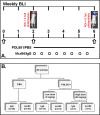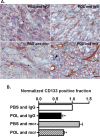Combined VEGF and CXCR4 antagonism targets the GBM stem cell population and synergistically improves survival in an intracranial mouse model of glioblastoma
- PMID: 25238146
- PMCID: PMC4259439
- DOI: 10.18632/oncotarget.2443
Combined VEGF and CXCR4 antagonism targets the GBM stem cell population and synergistically improves survival in an intracranial mouse model of glioblastoma
Abstract
Glioblastoma recurrence involves the persistence of a subpopulation of cells with enhanced tumor-initiating capacity (TIC) that reside within the perivascular space, or niche (PVN). Anti-angiogenic therapies may prevent the formation of new PVN but have not prevented recurrence in clinical trials, suggesting they cannot abrogate TIC activity. We hypothesized that combining anti-angiogenic therapy with blockade of PVN function would have superior anti-tumor activity. We tested this hypothesis in an established intracranial xenograft model of GBM using a monoclonal antibody specific for murine and human VEGF (mcr84) and a Protein Epitope Mimetic (PEM) CXCR4 antagonist, POL5551. When doses of POL5551 were increased to overcome an mcr84-induced improvement in vascular barrier function, combinatorial therapy significantly inhibited intracranial tumor growth and improved survival. Anti-tumor activity was associated with significant changes in tumor cell proliferation and apoptosis, and a reduction in the numbers of perivascular cells expressing the TIC marker nestin. A direct effect on TICs was demonstrated for POL5551, but not mcr84, in three primary patient-derived GBM isolates. These findings indicate that targeting the structure and function of the PVN has superior anti-tumor effect and provide a strong rationale for clinical evaluation of POL5551 and Avastin in patients with GBM.
Conflict of interest statement
BR, GD, EC, MPB and KD are all employed by Polyphor and own shares in the company. RAB is a consultant for, has equity interest in, and is a recipient of a sponsored research grant from Peregrine Pharmaceuticals and Affitech AS. R. A. Brekken is also an author of a patent on technology that was used to develop the antibody r84 by Peregrine Pharmaceuticals and Affitech. Peregrine and Affitech did not participate in the planning, execution, or interpretation of the experiments.
Figures






References
-
- Stewart LA. Chemotherapy in adult high-grade glioma: a systematic review and meta-analysis of individual patient data from 12 randomised trials. Lancet. 2002;359(9311):1011–1018. - PubMed
-
- Stupp R, Hegi ME, Mason WP, van den Bent MJ, Taphoorn MJ, Janzer RC, Ludwin SK, Allgeier A, Fisher B, Belanger K, Hau P, Brandes AA, Gijtenbeek J, Marosi C, Vecht CJ, Mokhtari K, et al. Effects of radiotherapy with concomitant and adjuvant temozolomide versus radiotherapy alone on survival in glioblastoma in a randomised phase III study: 5-year analysis of the EORTC-NCIC trial. The Lancet Oncology. 2009;10(5):459–466. - PubMed
-
- Zhou BB, Zhang H, Damelin M, Geles KG, Grindley JC, Dirks PB. Tumour-initiating cells: challenges and opportunities for anticancer drug discovery. Nature reviews Drug discovery. 2009;8(10):806–823. - PubMed
-
- Singh SK, Hawkins C, Clarke ID, Squire JA, Bayani J, Hide T, Henkelman RM, Cusimano MD, Dirks PB. Identification of human brain tumour initiating cells. Nature. 2004;432(7015):396–401. - PubMed
Publication types
MeSH terms
Substances
Grants and funding
LinkOut - more resources
Full Text Sources
Other Literature Sources
Medical
Research Materials

